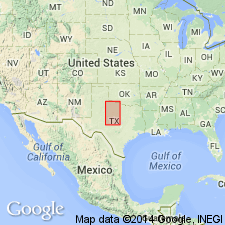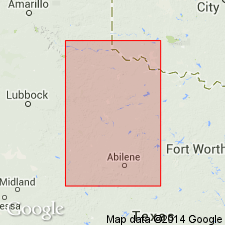
- Usage in publication:
-
- Sweetwater dolomite†
- Modifications:
-
- Abandoned
- AAPG geologic province:
-
- Permian basin
Summary:
Pg. 26. †Sweetwater dolomite. Replaced this (preoccupied) name with Claytonville dolomite, which E.H. Sellards (Univ. Texas Bull., no. 3232, p. 167, 1933) also adopted, instead of Sweetwater (preoccupied) and included it in Peacock formation.
Source: US geologic names lexicon (USGS Bull. 896, p. 2099).

- Usage in publication:
-
- Sweetwater dolomite
- Modifications:
-
- Original reference
- Dominant lithology:
-
- Dolomite
- AAPG geologic province:
-
- Permian basin
Summary:
Pg. 953, pl. 10. Sweetwater dolomite. Thin, persistent dolomite, in places fine-grained and sandy and in places coarsely crystalline; 1 to 3 feet thick. Directly underlies the Triassic in southwestern Fisher County and northern Nolan County, central northern Texas. Age is Permian.
Strikes N. 30 degrees W. through city of Sweetwater, [Nolan Co.], central northern TX, and is named after its outcrop there.
Source: US geologic names lexicon (USGS Bull. 896, p. 2099); GNC Texas Corr. Chart, sheet 3, Sept. 1930.
For more information, please contact Nancy Stamm, Geologic Names Committee Secretary.
Asterisk (*) indicates published by U.S. Geological Survey authors.
"No current usage" (†) implies that a name has been abandoned or has fallen into disuse. Former usage and, if known, replacement name given in parentheses ( ).
Slash (/) indicates name conflicts with nomenclatural guidelines (CSN, 1933; ACSN, 1961, 1970; NACSN, 1983, 2005, 2021). May be explained within brackets ([ ]).

